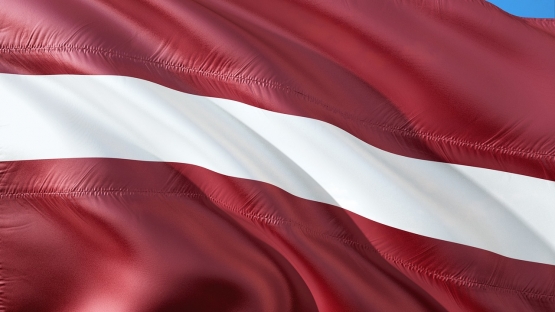Flag of the Republic of Latvia. (RonnyK/pixabay.com)
An International Atomic Energy Agency (IAEA) team of experts said Latvia is committed to strengthening its regulatory framework for nuclear and radiation safety. The team also noted areas for further enhancement, including the development of a national waste management policy.
The Integrated Regulatory Review Service (IRRS) team on 30 October concluded a 10-day mission to review the regulatory safety framework in Latvia. The mission was conducted at the request of the Government of Latvia and hosted by the country's regulatory body, the Radiation Safety Centre of State Environmental Service (RSC SES).
Using IAEA safety standards and international good practices, IRRS missions are designed to strengthen the effectiveness of the national regulatory infrastructure, while recognizing the responsibility of each State to ensure nuclear and radiation safety.
"The Latvian infrastructure for nuclear safety and radiation protection was created only after independence in 1990. Considering this relatively short history, the legal and regulatory system and controls are very well-developed," said team leader Ilmar Puskar, the Head of the Radiation Safety Department at the Estonian Environmental Board. "Latvia has demonstrated a strong commitment to nuclear and radiation safety," he added.
Latvia uses radiation sources in medical, scientific and industrial applications, as well as in science and research. The country's research reactor has been permanently closed since 1998 and is currently in the early stage of decommissioning. All spent highly enriched uranium fuel was sent back to the country of origin. Latvia operates a disposal site for low and intermediate level radioactive waste, which is located 30 km from the capital, Riga. Latvia does not operate a nuclear power plant and does not intend to build one.
"The IRRS mission was particularly important to us, as it is the first mission of its kind in the field of radiation safety to Latvia," said Dace Satrovska, Director of the RSC SES. "The preparatory self-assessment we conducted and the recommendations from the IRRS mission will be used to improve the regulatory framework in accordance with IAEA standards."
The 10-member IRRS team comprised eight senior regulatory experts from eight countries, as well as two IAEA staff members. The team conducted interviews and discussions with key personnel at the RSC SES and the Ministry of Environmental Protection and Regional Development. It observed on-site inspections conducted by RSC SES at a hospital in Riga and at Latvia's radioactive waste repository.
The IRRS team found RSC SES staff and leadership to be highly competent and dedicated to improving the safety of facilities and activities in Latvia. The team identified areas of good performance, such as the efficient assessment and improvement of the RSC SES management system.
The IRRS team identified several opportunities to further enhance the regulatory framework in Latvia including:
- The Government should include all IAEA safety fundamentals in a national policy and strategy for safety that covers all facilities and activities.
- The Government should develop a national policy to define long-term goals for the safe management of all classes of existing and future radioactive waste streams.
- The RSC SES should develop and implement a comprehensive human resource plan, including a specific training programme based on the assessment of necessary staff to perform its functions and to discharge its responsibilities.
The final mission report will be provided to the Government in about three months. The Government plans to make the report public.







